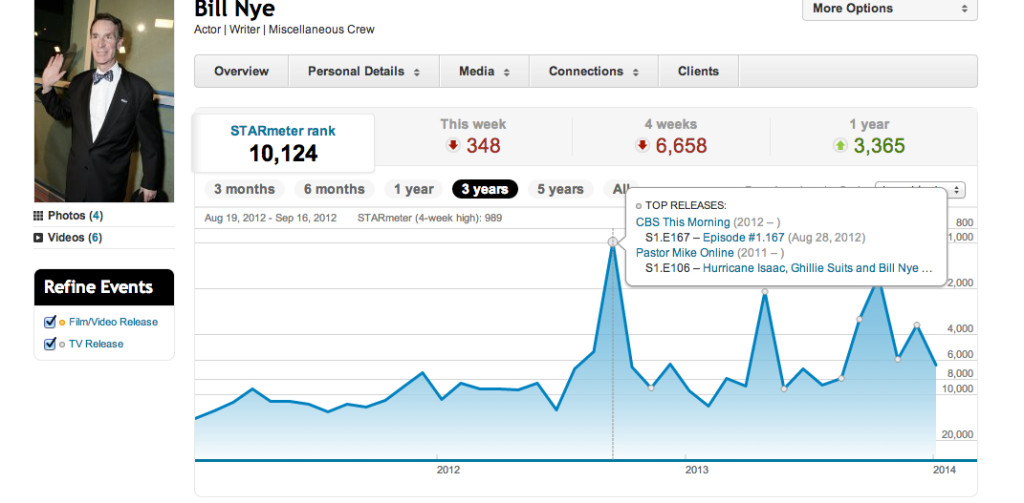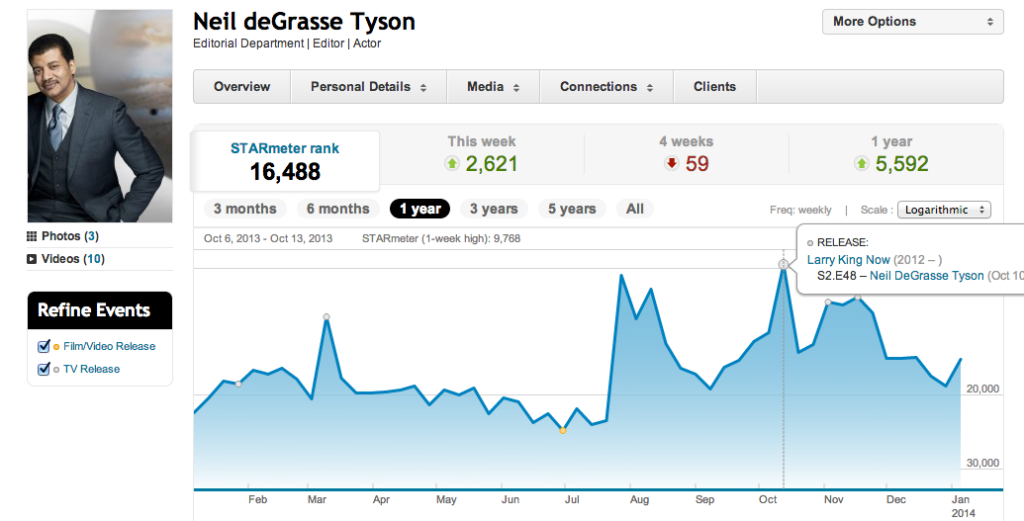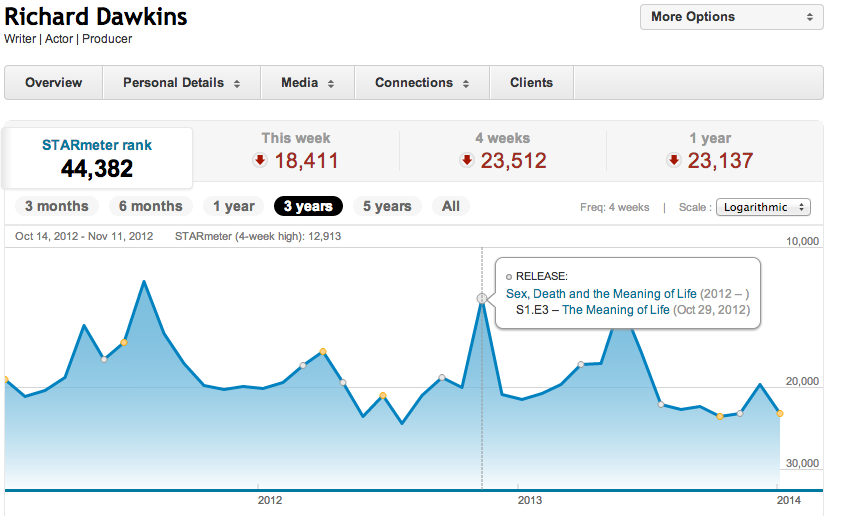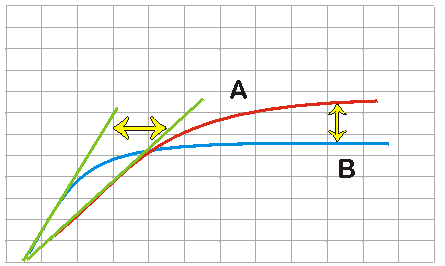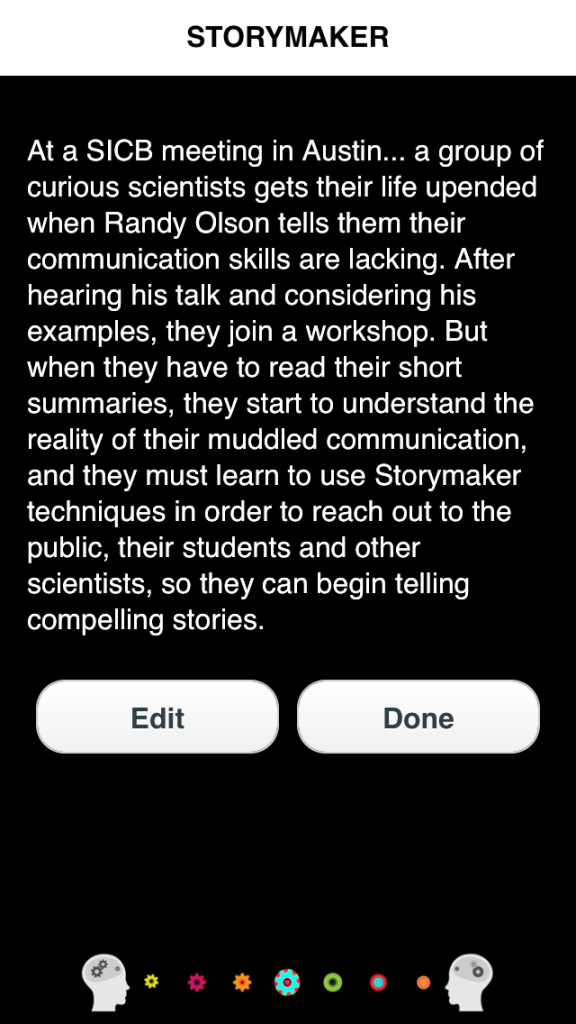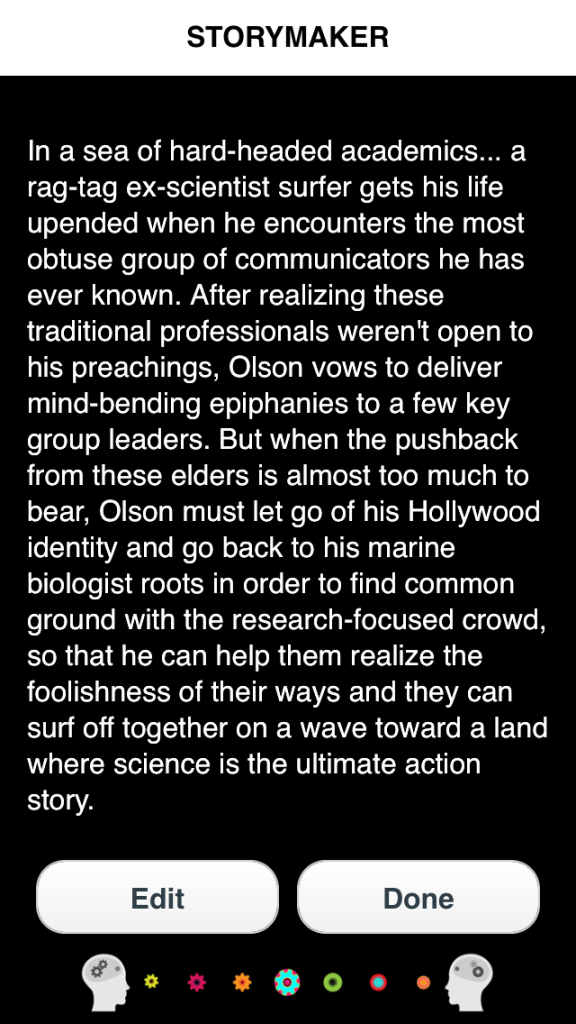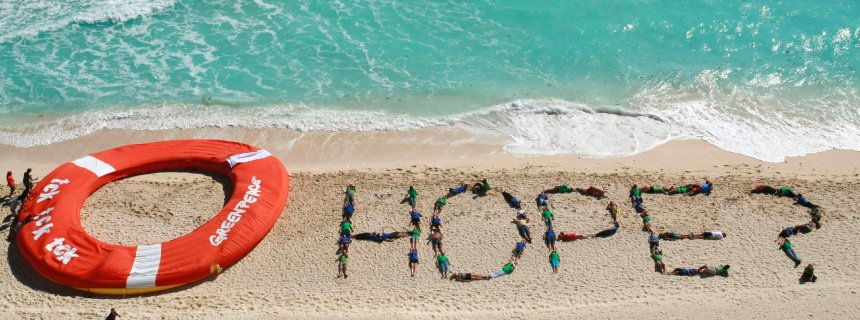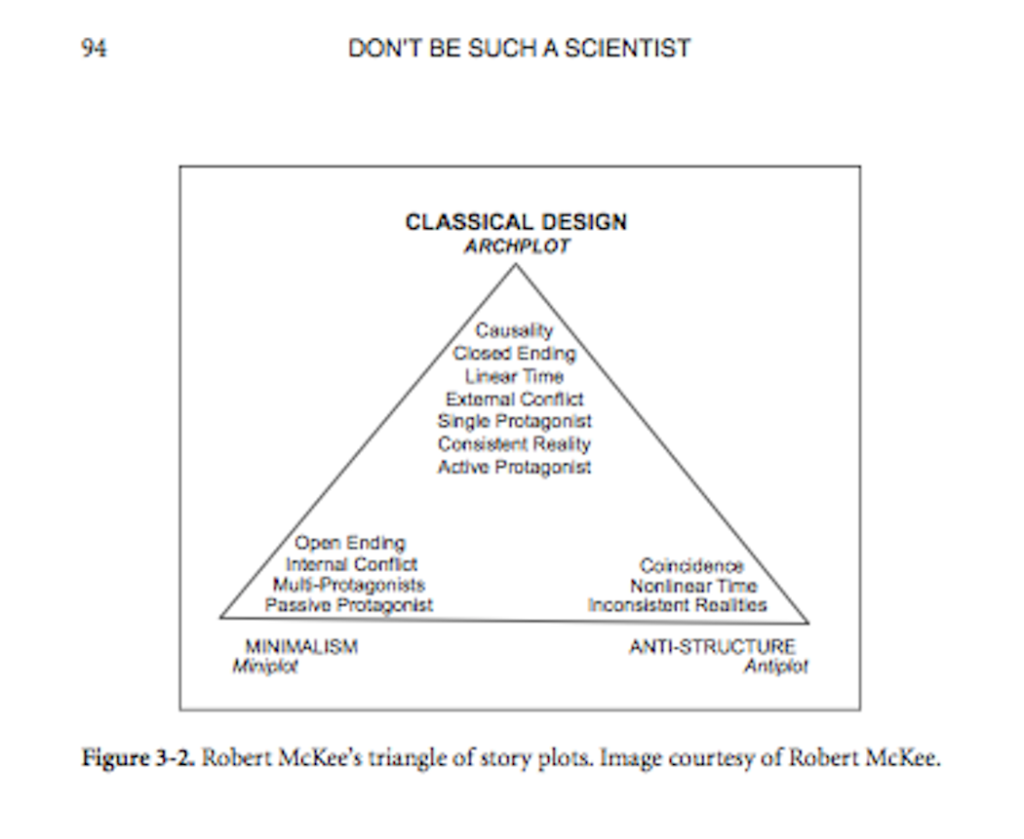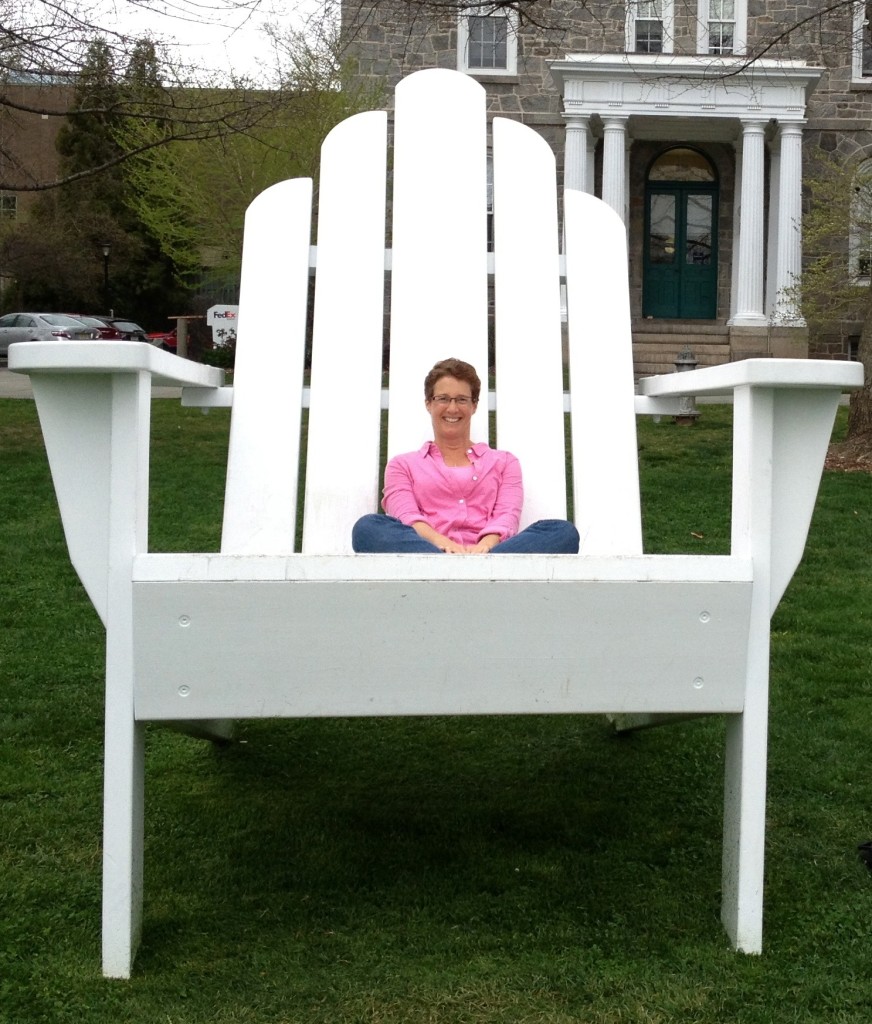#329) WSP MODEL: A New Perspective
January 9th, 2014
THIS IS AN IMPORTANT UPDATE. It’s been 4 months since we introduced our WSP Model through the book and app. We’re still learning how to use it. This is an intuitive look at the model. If you’ve struggled with the Logline Maker, this may help you get a little better perspective on its strength and use. Overall, it’s time to start looking at storytelling in terms of “Narrative Fitness Training,” and get away from this notion of becoming a great communicator in a one day workshop. It takes time.
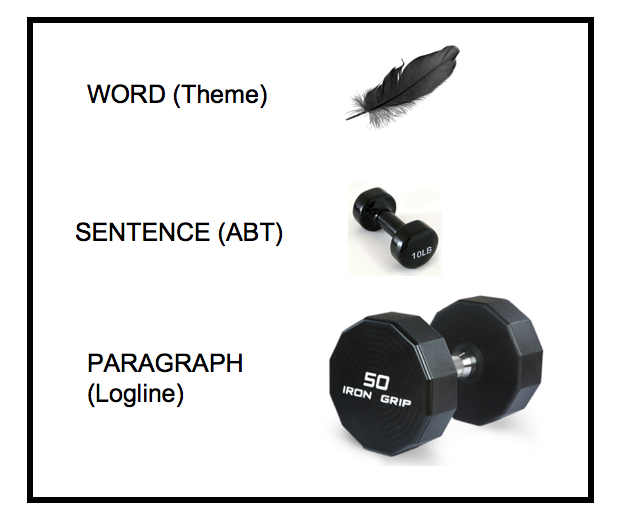 “NARRATIVE FITNESS TRAINING” AND AN INTUITIVE LOOK AT THE WSP MODEL. The “theme” is like a feather — light, wispy, elegant, but not that powerful. The “Logline” is the other end of the spectrum — a 50 lb weight that is the true powerhouse — it will take you a while to get strong enough with narrative to use it effectively. The “ABT” is the element that is riiiiiight in the middle (like Goldilocks) — universally applicable, yet still very simple — it is your best and most effective entry point in using the WSP Model. But in the long run, the Logline is the tool that will give you true narrative strength.
“NARRATIVE FITNESS TRAINING” AND AN INTUITIVE LOOK AT THE WSP MODEL. The “theme” is like a feather — light, wispy, elegant, but not that powerful. The “Logline” is the other end of the spectrum — a 50 lb weight that is the true powerhouse — it will take you a while to get strong enough with narrative to use it effectively. The “ABT” is the element that is riiiiiight in the middle (like Goldilocks) — universally applicable, yet still very simple — it is your best and most effective entry point in using the WSP Model. But in the long run, the Logline is the tool that will give you true narrative strength.
NARRATIVE INTUITION DOESN’T HAPPEN OVERNIGHT
I’ve come to realize this is the number one misconception we’re up against. Everyone is now celebrating “storytelling” as the great new cure for communication problems, which it ultimately is. But lots of people are giving the impression that it can be “learned” in a single day or a few days through workshops. It can’t. Not by any stretch.
If you doubt this, I have a few hundred thousand failed screenplays in Hollywood to show you.
Look who wins the Oscar for Best Screenplay each year. It kinda tends to be veteran screenwriters. In fact, let’s see, who won Best Original Screenplay last year … hmmm, a guy named Quentin Tarantino. You know, I saw him speak at the Directors Guild of America in 1998 when he was nominated for Best Director for “Pulp Fiction,” and he talked about the idea of being seen as an “overnight sensation.”
He said, “nobody talks about my twenties — I spent my entire twenties toiling away in obscurity — the best years of my life — ‘my topsoil years’ — squandered away trying to break into this business.” (Always loved that “topsoil years” phrase he came out with — he is truly a genius)
Which is the truth. I know, I’m buddies with the guy who hired him at the video store in Manhattan Beach back in the 80’s where they would all get together and watch countless movies and read screenplays. That was the “10,000 hours” of investment that Malcolm Gladwell talks about in his book, “Outliers.” The math is right there for Quentin, no mistaking it.
Effective storytelling only happens when the process moves down to the level of instinct, which does not happen in a one day workshop. It takes time. And this is becoming my new message for the New Year.
THE 50 LB WEIGHT OF THE LOGLINE MAKER
So this is the new diagram for our workshop and talks, and my overall message. The ABT is incredibly flexible, powerful and widely applicable. It is your entry point to narrative structure. But the Logline Maker is the real challenge, and you can spend an entire lifetime and never really master it.
Dorie, Brian and I have had some lengthy chats about this recently. We’ve seen it in our workshops. The ABT is hugely satisfying to work with for the participants while the Logline produces a lot of frustration.
We’ve been letting people try to jam their stories into it, which ends up being a bit of a square peg into a round hole problem. The Logline is complex and takes getting used to. But in the long run, it is THE tool for achieving the ultimate goal which is, “narrative intuition.”
“NARRATIVE FITNESS TRAINING”
So the big difference is that the Logline needs a much longer timeline than a single workshop. It’s something for everyone to slowly set to work with. We are now advocating a long term perspective with this stuff. If you’re really committed, it’s about setting yourself up on a weekly regimen — basically doing narrative fitness training.
We recommend 5 ABT’s a week and one Logline. Within a couple months you’ll start to see a difference. We guarantee it, or we’ll refund the money you didn’t spend when you downloaded the Connection Storymaker app for free (hopefully).
Bill Nye has committed to what is shaping up to be the highest profile “debate” of evolution versus creationism since the Scopes Monkey Trial of nearly a century ago. He will be debating Ken Ham, the colorful Director of the Creation Museum in Kentucky. Some major science voices have already recommended he not do it. But I think it’s a textbook case of the need to talk substance in an age of style. It’s a chance to put a popular, well liked face to the entire topic of evolution (plus if he has a single message at this point it’s his Youtube video that says creationism is not good for your kids which has over 6 million views). I support his doing it.
DATA! Feast your eyes on this, science fans. This is from the “pro” version of the Internet Movie DataBase (IMDB). Bill Nye hit a high of 989 a couple years ago. That’s impressive. And powerful. There is no higher profile voice for evolution right now (for comparison, see below, Neal deG. Tyson and Richard Dawkins have almost never even broken 10,000). Plus … they loved him on “Dancing with the Stars” meaning he has that magical, elusive thing that politicians would kill for called “likeability”!
TO DEBATE OR NOT TO DEBATE, THAT IS THE ETERNAL QUESTION
Through my two movies (Dodos and Sizzle) I got involved with both of the major science “debates” of evolution and global warming over the past decade. For the climate world I recommended in 2010 and again in 2013 that nobody debate climate skeptic Marc Morano (who was in Sizzle). One of the sources I cited for that was Genie Scott, long time Director of the National Center for Science Education and about the most important defender of evolution in this country. For a long time she has had a blanket policy of “don’t debate.”
Now Bill Nye, the highest profile voice for science in this country, has decided to defend evolution in a debate on February 4 at the Creation Museum in Kentucky.
Let me start by deferring to Gerald Graff, whom I interviewed in Flock of Dodos. He wrote two books that I cite frequently these days — “Beyond the Culture Wars: How Teaching the Conflicts Can Revitalize American Education,” and “They Say, I Say: The Moves That Matter in Academic Writing” I really think people should read his two books before they weigh in on this debating issue. The latter book has sold over a million copies and is now used in college courses across the country for the teaching of argumentation.
His point with “Beyond the Culture Wars” is that everyone learns best when there is a source of conflict (like a debate) to help focus attention. I wholeheartedly agree with this. (And guess where else conflict is essential — in the telling of stories).
More to the point, look at how much broad media coverage evolution has received over the past 20 years. A decade ago the conflict and debate around the teaching of intelligent design put it on the cover of every major magazine and helped propel my movie on to Showtime. Now all the mass media attention to evolution has died down.
Yes, I know some scientists find the mass media to be a lot of distracting noise, but we did more than a couple hundred large screenings of Flock of Dodos and I’m sure several hundred thousand people saw the movie through Showtime and Netflix. This is how you educate the masses — through debate and conflict. Bill Nye understands this.
SO WHICH TEAM IS MY FAVORITE CELEBRITY ON?
I have spent more than 20 years hanging around Hollywood, often involved in celebrity events for everything from the oceans to hunger relief to disaster relief in Haiti to just good old fashioned parties in the Hollywood Hills that rage until sunrise (where people like Vince Vaughn or Winona Ryder show up drunk, ah, the good old days of film school). I also grew up in Kansas and have lots of friends and family there still, whom I visit several times a year.
This may just be my naive take, but I think most people away from the coasts don’t really care that much what celebrities have to say specifically about an issue, they just want to know, “Which team is my favorite celebrity on?”
Gun control? Just tell me which team George Clooney is on. Affordable Care? Just tell me which team Jay Z is on. Immigration Reform? Just tell me which team Jennifer Lawrence is on.
SO WHO IS ON THE EVOLUTION TEAM?
Pretty much nobody for celebrities. Sorry. I mean that in relative terms. There are armies of celebs on the environmental team. I’ve turned out bunches of them for PSA’s and events in Hollywood. It’s a piece of cake. Same for hunger, disease, and everything else that physically improves people’s lives in obvious ways. But evolution is not the same.
We had one major TV actor who helped us with our Shifting Baselines campaign — the star of a top ten TV show and a great guy. My assistant Ty had several interesting and substantive chats with him. So I got ready to make a pitch to him about doing a pro-evolution PSA around the time of Dodos, then we spotted an interview where he talked in depth about his “spirituality” and closeness to God. Which ended that line of thought.
And that’s the deal. Most celebs are very “spiritual,” as are the bulk of their fans. Evolution is perceived as non-spiritual. Yes, I know lots of evolutionists are religious, but we’re not talking about reality here, only perception (that’s all that matters in the media world). It just is. And so there are very, very few celebrities willing to step forward in its defense. I’ve talked with Genie Scott about this numerous times. It’s a challenge. Yes, there’s a few (like Seth MacFarlane who is awesome about it). But only a very few. It’s not like other issues.
BILL NYE HAS THE ELUSIVE LIKEABILITY FACTOR, SO USE IT
I was surprised to see his appearance on “Dancing With The Stars” last fall didn’t shoot him up above 1,000 on the Starmeter (see above). Regardless, he scored a ton of media exposure and most importantly, the fans LOVED him. No other scientist has that sort of mass adoration at the moment. Maybe Neil deGrasse Tyson will get it with his upcoming “Cosmos: A Space-Time Odyssey” series (for which Seth MacFarlane is an executive producer). Richard Dawkins can forget about it with his recent endorsement of “mild pedophelia” (doesn’t matter if he doesn’t really endorse it, he or his publicist allowed the perception to arise in the media).
More importantly, what this event is about is the subtitle of my first book, “Talking Substance in an Age of Style.” The general public doesn’t really want to hear the details of how evolution works. They just want the STYLE component — in two ways: which team are my celebs on, AND what are the spokespeople for each side like — SPECIFICALLY do I LIKE and TRUST the guy who is speaking for evolution?
And don’t take my word on this — as always, I defer to Nobel Laureate Daniel Kahneman, who told the National Academy of Sciences your voice needs to be “trusted and liked.”
Some angry and dismissive evolution professor (of the sort that debated an intelligent designer in the Seattle Town Hall a decade ago that I mentioned in my book) is not going to do squat for the evolution cause.
Bill Nye is not angry, not dismissive, not arrogant, and is perceived as fun, friendly and trustworthy.
Yes, the academics will probably find some moments to chop him up over whether he talks about the proper selection coefficients when it comes to allopatric speciation, but the general public … they could care a less.
This is a high profile event BECAUSE Bill is doing it. It will get lots of media attention. Despite many pro-science folks on blogs saying they would not give their $25 for a ticket, the event supposedly sold out in 2 minutes.
It’s time for the media to start cranking up the “New Millenial Scopes Trial” angle on it. There will be very little “teaching” that takes place with it. But there will be plenty of “imagemaking” for the entire subject of evolution.
The best thing that could happen is that Nye gets under the skin of Ken Ham, causing him to have a few unlikeable moments. That will go much further than any effort to “go for the jugular” (sheesh, that was the line a whole bunch of academics said they wished I had done with “Flock of Dodos” — as if there has EVER been a jugular for the creationists) by supposedly “out-arguing” the creationist.
Bill Nye is broadly popular. He’s already won the “debate.”
TYSON AND DAWKINS: NOT IN THE SAME LEAGUE WITH NYE
Here’s the Starmeter plots for these two guys who are probably the next highest profile entertainment voices for science. They both hover in the 10,000 to 20,000 range while Bill Nye is firmly better than 10,000.
#327) A Storify Log of Randy Olson’s SICB Visit (assembled by Steph Yin)
January 7th, 2014
Hello Benshi readers! My name is Steph Yin, and I’ve been working with Randy Olson on social media outreach since August. I attended the Annual Meeting of the Society for Integrative and Comparative Biology with Randy this past weekend, and tweeted about it. In case you missed it (especially if you meant to attend but were thwarted by snow!), I’ve Storified it below with commentary and extra links. Feel free to join in on the conversation on Twitter: Randy’s at @theBenshi.
#326) SICB Plenary: Trying to Sway Tough Science Minds
January 6th, 2014
Tough crowd. Bred to negate. But they understand something important: large scale change takes long term effort. Nevertheless, they could all stand to learn more about Joseph Campbell and what he had to say about the telling of stories. The best place to start is Dorie‘s section of our book, “Connection.”
AUDIENCES CAN BE LIKE ENZYME KINETICS. The blue B curve would be the business and Hollywood communities who are quick to adopt new ideas, but have too short of an attention span to gain full value from the ideas. The red A curve would be research scientists like the folks at SICB who are VERY resistant to change, but have the long attention span, enabling them to eventually get the full value of a new idea (assuming everyone lives long enough to see it happen).
BRED TO NEGATE
Okay, before we get started here, take a look at this heading, “BRED TO NEGATE” and think about what your immediate response to it is. If your first thought is, “Well, I wouldn’t really say scientists are “bred to negate,” just think for a second whether you realize you are starting by wanting to negate that heading. I’m just asking you to consider whether you’re really aware of how much you start just about every thought with a process of negation. Not saying it’s wrong. Just asking if you’re aware of it (which was a major part of my book, “Don’t Be Such a Scientist“). That’s all for now.
I just had a really wonderful 3 days in Austin where I gave the Opening Plenary at the annual meeting of the Society for Integrative and Comparative Biology to about 700 scientists, then we ran a 90 minute sample version of our Connection Storymaker Workshop. All 16 slots for the workshop were filled, but in addition, about another 40 people showed up to observe, which was cool and impressive.
I used to be a member of SICB when it was The American Society of Zoologists so there was an element of “old home week,” to my visit — especially as my Ph.D. advisor, Ken Sebens, introduced me for the big talk by calling me “the Jane Goodall of sea squirts” (she lived in the wild with her primates she was studying, I spent 6 to 8 hours a day underwater on the Great Barrier Reef with the sea squirts I was studying).
Lots of fun reunions with people — some I hadn’t seen for over 20 years, but make no mistake, SICB is a tough crowd. And they showed it after my big talk. Unlike audiences I speak to from the business community (who are on at one end of the acceptance spectrum shown below) there was a strongly negative, critical tone to this group. Which is a good thing in terms of them valuing truth and accuracy over all else, but is also sort of life-draining when it comes to broad communication.
In my first book I talked at length about the need to balance negativity and positivity. It does no good to be a brainless Hollywood producer who says yes to everything (it is the driving force behind $100 million movies that flop). But just the same, starting all conversations with “no” simply does not work for communication. It is great and essential for good scientific research, but when it comes time to communicate, the process just is not as simple as negating things to pieces. Sorry. It just isn’t. And you really should trust me on this (before saying, “No, I think that…”). I’ve put in a lot of years in two professions. And yet … I could feel that a lot of the audience didn’t care. They needed to prove these things to themselves. And yet aren’t interested in spending 20 years in Hollywood to fully learn it. Which really doesn’t add up in the end.
THE REASON EVERYTHING YOU SAY IS WRONG IS …
I seriously have never sensed this vibe from an audience as clearly as I did on Friday evening. There were lots of positive and enthusiastic comments after the talk, but even the three question/comments asked in the Q&A had this tone of, “The way in which you’re wrong here is …”
One question was about excessive use of the Hero’s Journey template leading to homogenization, one was about my failing to grasp how “special” science is (when the questioner actually failed to grasp Joseph Campbell’s use of the word “special” which I had clearly explained), and the third was disagreeing with my low opinion of the “and, and, and” structure.
As a group, it was just SO different than what I’m accustomed to. When I speak at CDC, at the Society for Hospital Leadership, with business groups, with Hollywood folks, there is a basic tone of, “this is great, can you say more about how we can put this knowledge to use.” But with this group … the basic tone was sort of, “I don’t know … I’m going to have to think this stuff through.”
Very conservative. Anti-change. Anti-innovation.
And why do I say this so confidently — because I was a member. I know it all too well. Tough crowd. When it ended, a group of about 20 people came up who were mostly great, but the first to talk was a Scottish grad student who rather tersely pointed out I had no data, no controlled studies, no published peer-reviewed papers — nothing but anecdotes and speculation … to which all I can say is, dude, communication is not the same as research — trust me, I’ve done both, you haven’t, I know what I’m talking about here.
If your communication strategy is going to be based ONLY on “facts” that arise from data sets and controlled studies you’re going to have very little to say at the podium. It just isn’t the same. There’s a real world element that is different from the cloistered setting of the research laboratory.
THE SPECTRUM OF AUDIENCE CHEMISTRY
SCIENTISTS PUBLIC HEALTH BUSINESS COMMUNITY
I——————————————————————————I——————————————————————————–I
(NEGATION-DRIVEN) (AFFIRMATION-DRIVEN)
So I’m not looking to argue about this. Don’t waste your time. I’m just telling you this is what I see. I talk to all these different audiences. They end up falling along a spectrum. At one end there is the business and Hollywood crowd. They are full of energy, excitement, and eagerness to try new ideas. BUT … it’s kind of hard to get them to stay focused and actually take an idea the whole distance. Also, while they gobble up the storytelling stuff, they really have little interest in this thing called “accuracy.” They just want to get people excited so they can make money.
In the middle is the public health crowd — much more concerned that their public health facts get communicated in an accurate manner, but also, because they have the word PUBLIC in their field of work, feel strongly compelled to communicate effectively.
And then there are the scientists … I beat them up enough in my first book, “Don’t Be Such a Scientist.” They are just tough. But on the up side, I felt one thing very clearly after my talk that gave me hope, which is that as I explained the need for “narrative training” and the fact that it is something that requires a long term perspective and commitment … THAT is where I saw a ray of inspiration. They get it on that front. Hollywood and the business world, it is well known, have zero interest in anything beyond the next fiscal year. This is how science differs. It comes at the cost of that grouchy, negating attitude in the short term. But it is eventually balanced out by this ability to think in the long term.
THE SICB COMMUNICATORS JOURNEY (TWICE TOLD)
So just to prove that despite this negating atmosphere, there were still more than enough awesome wonderful enthusiastic people, two of them on their own downloaded our Connection Storymaker app, then used the Logline Maker to tell MY story at SICB and emailed their stories to me, which is hilarious. Thank goodness for these people. They give me hope for the long term, even with tough crowds like SICB.
#325) HAPPY NEW YEAR: We’re Gonna Survive!!! (which just heightens the narrative imperative)
January 1st, 2014
Two really good essays from Think Progress and the Breakthrough Institute paint a clear picture of the planet and it’s not as grim as a lot of people would prefer. But this just makes the communication challenge more difficult than ever. It’s easy to communicate the truth when the truth is insanely urgent and dramatic (the recent documentary “Blackfish” is an excellent example of this—the power of whales and human death override any narrative imperative). But what do you do when the problems become more long term, subtle and less visible. You have two options: lie or get better at communication. I’m for the latter.
THE WORLD’S NOT GONNA END IN 2014. I don’t think. If I’m wrong you can sue me. (Cool painting from KM Kimura)
TWO MESSAGES OF GUARDED ENVIRONMENTAL OPTIMISM
2013 has ended with the Breakthrough Institute calling it, “A Year of Hope and Change for the Environment,” and Think Progress going even further, calling it, “The Best Year in Human History.”
Take that, Debbie Downer.
I’m in total agreement, and yet there is the endless challenge of walking the fine line between “guarded optimism” versus ill-informed environmental “skepticism,” of the Bjorn Lomborg variety.
The only thing I know for sure is that it calls for even more focus on skillful and accurate communication. Rallying the masses is easy when the threats are large, obvious, urgent and with high stakes. But a whole lot harder when they’re not.
BLACKFISH: CASE IN POINT
The recent documentary “Blackfish” is excellent and everyone should watch and support it. I was an undergraduate at the University of Washington in 1976 when the good people of Puget Sound finally rose up against the horrible practices of Sea World and kicked them out of the state for good. I would like to say I was a major part of that effort, but, alas, I was 21, living in a fraternity with only two things on my mind, the environment not being one of them. But I do recall being incredibly disgusted at the stories I heard from friends who went out there and joined in the protest. Sea World has now spent generations doing horrible things to orcas. They need to stop. And apologize for their greed.
“Blackfish” ends up being a case study in the rare instance where you really don’t need to work too hard on overall narrative dynamics. The movie doesn’t tell much of an overall story, other than these people are horrible and need to be stopped. It is the very sort of “And, And, And,” collection of vignettes that I warn against in my Science letter. And yet, the fact is, if your raw material is just incredibly engrossing and dramatic and watchable by itself, there is the rare instance when that’s all you need. And this movie is it.
In fact, it’s elegant how cleanly and simply the material is presented. Just one tragic tale after another of shoddy practices which have eventually caused the loss of lives while the animals continue to suffer.
But this is indeed the rare exception. Just look at the subject matter—whales. You couldn’t have a more immediately compelling topic to begin with. Whales and human death—can’t beat that.
GLOBAL WARMING IS NO WHALE TALE
So that’s the problem. Whales and death—an easy sell—little need to sweat it on the overall narrative front. Climate change and human discomfort eventually leading to death through chains of events … that’s a much tougher challenge.
All of which sets the stage for the big climate communications extravaganza of 2014 — the upcoming Showtime series, “The Years of Living Dangerously.” In my Der Spiegel interview (picked up last week by ABC News) I had talked about it as a possible source of hope in combatting the bo-ho-horingness of global warming, but that material didn’t make the cut, which is a shame.
I know that a lot of good people have worked very hard on the series, and they have the best possible science advisor with my buddy Joe Romm, the longtime climate blogger, so you can be assured the science of the series will be excellent.
I’m looking forward to it and hope it becomes a role model for how to “do it right” in the broad communication of a serious environmental issue.
Here’s to 2014 being, “The Best Year in Environmental Communication”!
#324) GAVIN SCHMIDT vs. TAMSIN EDWARDS on climate science advocacy: I’m with Gavin
December 27th, 2013
In a perfect world, I’m with Tamsin Edwards (who says scientists should stay clear of all potential controversy). But we don’t live in a perfect world. Gavin Schmidt knows this and articulated it well in his recent AGU talk. He argued that yes, scientists should be willing to speak up. I want to just add a few of my thoughts on this issue based on what I witnessed in my years of coral reef ecology and coral reef conservation. Bottom line: I’m in total agreement.
#323) All I want for Christmas is an Unboring Planet
December 23rd, 2013
Der Spiegel did a 10 question interview with me asking why I feel that global warming is the most “bo-ho-horing” topic in the history of humanity. Boring is not a good thing, but there is hope. It’s called “Narrative Training.” Which now completes my couplet of two articles this month: PROBLEM – BOREDOM (Der Spiegel), SOLUTION – NARRATIVE TRAINING (Science).
YES, THERE IS HOPE. It exists in the form of “Narrative Training.” Teach the good people to not be boring and you can change the world. (the catch is that most of the truly good people I know are kinda reeeaally boring)
HOPE FOR HUMANITY (KIND OF)
Got a couple fun things here. First, the German magazine Der Spiegel let me vent my spleen a bit on the innate tendency towards boredom among humanity in general in an article titled, “Filmmaker Randy Olson: Climate Change is Bo-Ho-Horing.”
Actually, the original German version from Axel Bojanowski is I think it much better than their English translation. A German friend of mine read it and said, “It’s very Douglas Adams.” Which sounded great to me since Douglas Adams is the guy who solved the ultimate question of life, the universe and everything, which turned out to be 42. I’m afraid the English version feels a little less fun, and a lot more blunt. Something was clearly lost in translation.
Second, my letter in Science of three weeks ago did exactly what I had hoped — it flushed out the very sort of fellow from the humanities whom I knew must exist, yet had no way of finding. His name is Barry Woods, he is an associate professor in the English Department at the University of Houston, and he teaches an undergraduate interdisciplinary course that is hugely popular and filled to capacity every year titled, “COSMIC NARRATIVES: A history of the Universe from its beginning to the present.”
Bingo. THAT is the guy I was hoping to meet — someone who has converged on the same answer as I (which is NARRATIVE INSTINCT), but from the humanities rather than the sciences. We had a great hour long phone chat then traded a bunch of emails. I knew his sort of thinking was out there, but it’s so hard to cross disciplines and find it.
For starters, he loved my term, “storyphobia,” in my letter because he has learned the same thing — scientists hate the word “story,” and yet are perfectly comfortable with the word, “narrative.” He sent me his syllabus. Every section is “the narrative” of this or that. And it’s easy to see the problem. If you replaced the word “narrative” with “story,” it would indeed sound pretty light weight — the first section of, “What are cosmic narratives? ” becomes, “What are cosmic stories ?” — the former sounds analytical, the latter sounds like Superman.
After matching notes on a whole bunch of things, my final question to him was, “Do you think narrative structure is the best possible antidote to being boring?” His answer was yes, he agrees.
And that’s it. I’ve been exploring one major question for the past 20 years of my life.
What makes the world boring and how do we avoid it?
There you go. The answer is as simple as 42.
#322) Revkin: On the Right Track with Global Warming and Simple Storytelling Problem
December 16th, 2013
Andy Revkin has a great post today asking the question of whether “the villain” for global warming isn’t so diffuse and hard to define that we are crippled in trying to get the masses to focus and rally. That is my kind of thinking. Just look at Robert McKee‘s Triangle — it’s right there. ARCHPLOT is how you reach the masses the best. It calls for a single protagonist, and just the same, a single antagonist. Anything short of this starts to drift you down into the artsy world of MINIPLOT, and thus a smaller audience.
That’s sort of the question Andy Revkin posed today in his essay titled, “Can We Respond to Problems like Global Warming Where There’s ‘No Simple Villain’?”
And it’s even more than just that the threat is diffuse and multi-facted. It’s also the famous Pogo quote that “We have met the enemy and he is us.”
I won’t do my usual grandstanding here. I only encourage you to read Andy’s piece — he’s on the right track.
#321) VIDEO: Chris Palmer is a Voice for the Future of Nature
December 12th, 2013
For nature to stand any chance of surviving humanity’s reign, the media will have to play a major role. At this point we are a media-driven species. This means the media needs the right approach to understanding wildlife — which means not making animals into clown figures, not concocting untrue scenarios (like lemmings and cliffs), and not exploiting the hell out of every piece of violent, blood-soaked scene of natural (and staged) predation. Towards this end, Chris Palmer presents the clearest, most compelling voice articulating and advocating these values in wildlife filmmaking. He’s a great guy with a great mission, and everyone interested in protecting nature should watch this new video from him, hosted by Alexandra Cousteau, based on his excellent book, Shooting in the Wild.
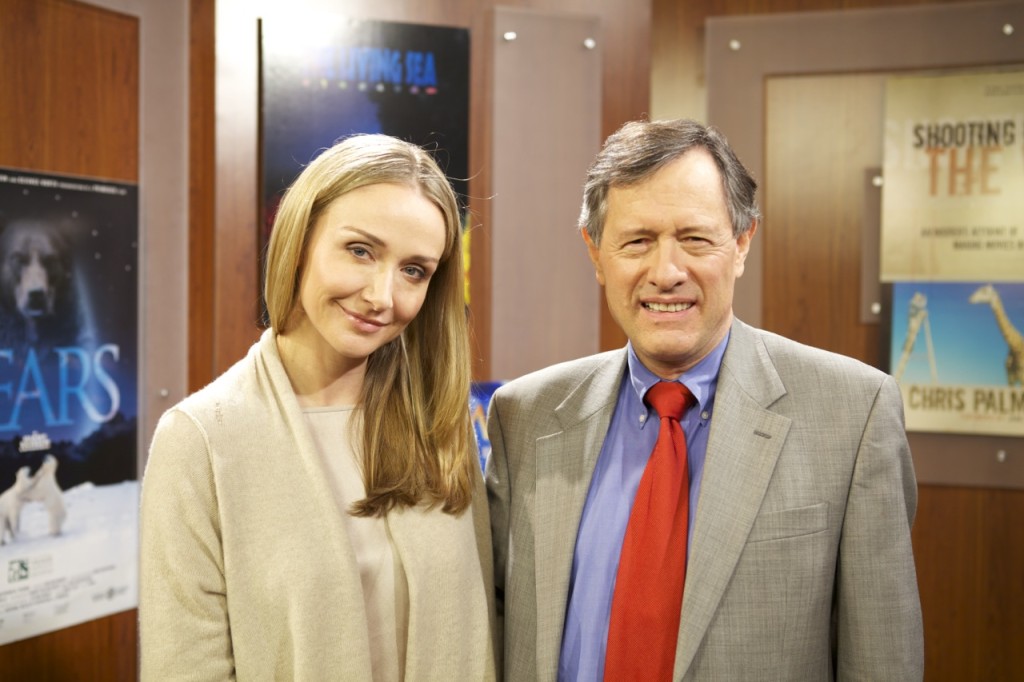
THE TRUTH ABOUT LEMMINGS. Among many wildlife filmmaking falsehoods Chris Palmer and Alexandra Cousteau try to set straight in their new 25 minute video, “Shooting in the Wild,” is that lemmings don’t jump off cliffs (though they may be thrown off cliffs for a Disney movie).
A VOICE IN THE COMMERCIAL WILDERNESS.
I have a few pet topics here on the Benshi that recur frequently. One of them is the importance of veteran wildlife filmmaker Chris Palmer’s work to establish a set of ethics for wildlife filmmakers. The whole idea of “ethics” seems old fashioned in today’s internet-obsessed world where there seems to be a belief that everything can just be left up to the knowledge of “the crowd” with no need for anyone to speak up. Which is misguided. And the reason why both his acclaimed book, Shooting in the Wild, and this film need to be promoted widely.
In particular, what I have consistently admired about Chris has been his work in speaking out against the exploitative practices of the Discovery Channel with their Shark Week bonanza of the past 25 years. He has written essays in the Huffington Post, and I have admired those essays in posts here and here.
And guess what he says in the video — this past year Discovery has finally shifted their tone from scare mongering about sharks to concern about their worldwide decimation. About time, dudes (just don’t get me started on all the stories I have from my USC film school classmates who have had to work on the countless crap shows Discovery and National Geographic have produced over the years in their desperate search for ratings). I have to think Chris’s voice has been a major factor pushing Discovery to develop a little bit of a conscience.
A MAN WHO KNOWS HIS JOSEPH CAMPBELL
What is very cool about the video is how it opens with basically “the flawed protagonist,” of Joseph Campbell‘s “Hero’s Journey” (which Dorie Barton adapted into her Logline Maker in our Connection Storymaker app). Instead of talking from some high and mighty position as a virtuous wildlife filmmaker who has never committed a sin, looking down on the heathens who are ruining nature with their cameras (which would be the idea of an “unflawed protagonist”), Chris begins by admitting he has taken part in the very unethical acts that he now is speaking out against.
Which is powerful and persuasive.
He tells of staging shots and misleading viewers (granted, long ago in his filmmaking career) for the sake of “telling a better story.” His transgressions back then are minor compared to the trends towards “animal porn” that eventually emerged when wildlife filmmakers began to realize how much money there was in showing sharks and lions tearing wildlife to pieces (not to mention footage of monkey sex and every other imaginable animal orgy– btw, a friend JUST told me about being contacted by a researcher from one of those channels seeking footage on “rape” in any species of animal — how lovely).
Chris is now a professor at American University sharing his years of knowledge with students and producing superstars like recent graduate Jackie Yeary who ended up being part of our social media team last summer for the release of our book, Connection.
So if you want to listen to voices that are truly standing up for the proper and ethical approach to nature, you have to read his book, follow his blog, and also follow the great work of a younger voice from South Africa (now residing in NYC), Adam Welz, who takes on the same issues on his excellent and popular blog, Nature Up for the Guardian (he has a great piece this week on how some US environmental websites have become infested with cutesy cat and dog stories — and in a similar “flawed protagonist” move he opens with a photo of his own cat — hey, we’re all human!).
#320) My Letter in Science: What a short strange trip it’s been
December 9th, 2013
This week I have a letter in Science — the culmination of a rather amazing series of highs and lows.
THE FACE OF INNOVATION. Megan Bailiff was the one responsible for our very effective plenary panel at CERF on November 5 which produced this Letter in Science this week. She is the one who changed the course of events at the very start by saying to me, “Everyone has had enough of the standard droning panel discussions — we want you to try something different using your narrative approach — even if it fails — we just want something new and different.”
LIFE IS GREAT, TERRIBLE, GREAT, TERRIBLE, GREAT …
My Letter in Science this week tells a brief, cool story about the making of our Plenary Panel at CERF. But here’s the full story, in all it’s roller coaster painful detail.
HIGH: INVITATION – Last summer my good friend Megan Bailiff asked me to join a plenary panel at the November meeting of the Coastal and Estuarine Research Foundation, telling me it would be a great chance to promote my new book and app, so I agreed.
LOW: MIX-UP – In September I looked at the website for the event — the panel was about Sea Level Rise with zero mention of communication, and I looked like a doofus up against two world experts on Sea Level Rise since I know nothing on the subject.
HIGH: CLARITY – I called Megan, fairly grouchy, saying, “What have you gotten me into?” but she explained that was exactly the idea — she wanted me to “do a makeover on the panel” as she assured me the two panelists were DYING to have me completely overturn their standard presentations, which sounded like fun to me.
LOW: GET LOST – Turned out the two panelists had no interest in having me experiment on them (for which I couldn’t blame them), they had limited time to prepare for the event, one of them was out of the country, and within a couple days we were caught up in an email spat over my novel ideas and their preference for the usual thing.
REALLY LOW: I QUIT – After viewing their combined 94 slides and sensing their resistance, I did the dignified thing — I quit. I called Megan. She was graceful in accepting my withdrawal, only conveying sadness as she had such high hopes, and then …
HIGH: I UNQUIT – Honest to goodness — just before I hung up, an email popped up from one of the two panelists — they had discussed it, decided they were senior enough that they could endure one major debacle in their career, so why not — let’s give it a shot. Within ten minutes I was on Skype with him and we were instantly connecting on every question — I would ask, “Have you got a story that shows this …” he would answer, “Yes, I know exactly what you want, yes, I’ve got that.” The vision was springing together.
LOW: ABANDONMENT – A few weeks before the meeting Megan sent us an apologetic email saying she had to travel to Fiji in November and wouldn’t be able to attend the meeting to see our panel.
HIGH: ANTICIPATION – The three of us panelists met at the hotel the day before the big event, all genuinely excited, more nervous than any of us had been in years in preparation for a presentation. We had put in a lot of effort and figured something good would have to come of it, but still, you never can tell how these things can go seriously wrong.
SHOCKING LOW: BOATING ACCIDENT – Mike Orbach showed up for dinner shaken, having just received a text message from Megan — she was on her way to Brisbane, Australia, from Fiji where she had been involved in a serious boating accident, so severe they couldn’t handle her injuries at the hospitals in Fiji.
SHOCKING HIGH: GREAT PERFORMANCE – With her spirit hanging over the event, we put on the panel, and it exceeded our expectations producing incredible raves from the 1,000 audience members (detailed here). Basically our grand experiment worked!
HORRIFYING LOW: NEAR FATALITY – Later that day the details emerged about Megan’s accident — she nearly lost her life — she was run over by a boat while snorkeling in front of it — the impact of the bow fractured her skull and shattered her shoulder then the boat veered and ran over her — the propeller hit her back, breaking ribs, puncturing a lung, crushing her left femur, slicing her calf muscle and heel. She was eventually “jet-evaced” to Brisbane (which has a world class trauma center) where she underwent 7 operations in 8 days.
THE FINAL CONSOLATION PRIZE: MY LETTER IN SCIENCE – So … after all that … Megan is now back in San Diego where she’s in for months of further work and physical therapy, however she’s already stunned the doctors by recovering much faster than expected. In just a month her shoulder bones are healing and ahead of all their predictions. The thing that I can’t get over in my conversations with her is how consistently upbeat and positive she is with her attitude. Not one complaint, just focused on moving forward in her physical therapy.
And guess what — this is not a coincidence — that this person who came to the planning of a big event with the attitude of “let’s try something new” is also the fighter who so impresses the doctors.
Anyhow, wow. What a short, strange trip. The event that nearly melted down turned out to be one of the coolest experiences of my entire professional life (you can view the entire CERF plenary panel here). Megan ended up being “incredibly lucky” to have survived such a horrific accident (though as she and I have agreed, it would have been “incredibly luckier” to have never been hit by the boat).
Overall, the entire experience tracks back to Megan’s initial desire to do something new. This is the spirit that is desperately needed in science and environmental communication. The world has changed. The audiences have changed. We can’t go on doing the same old dull presentations. This stuff is too important. There has to be innovation. For this, we need more people like Megan Bailiff who are willing to push things in that direction.
I really mean this.
